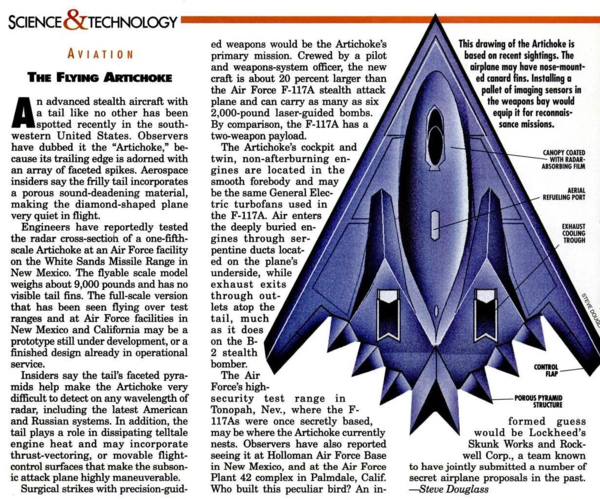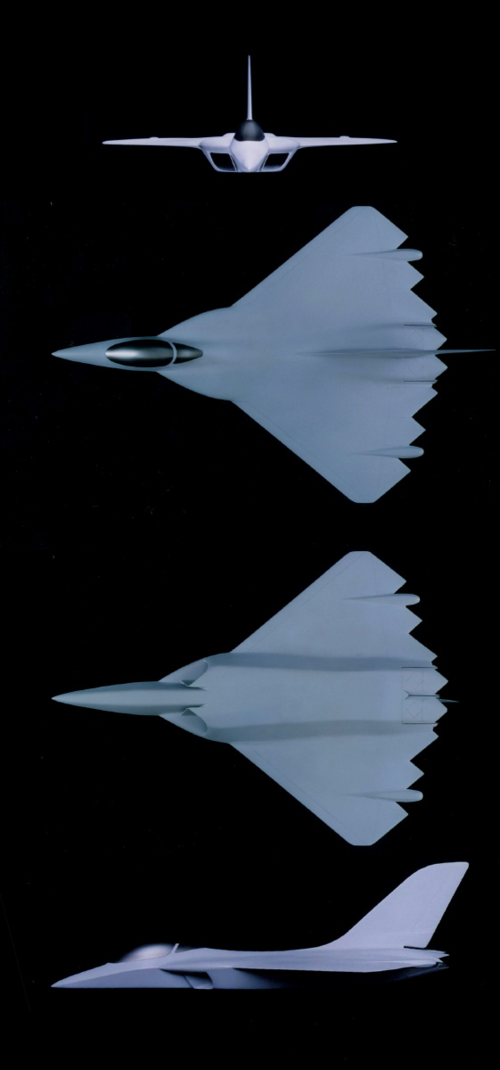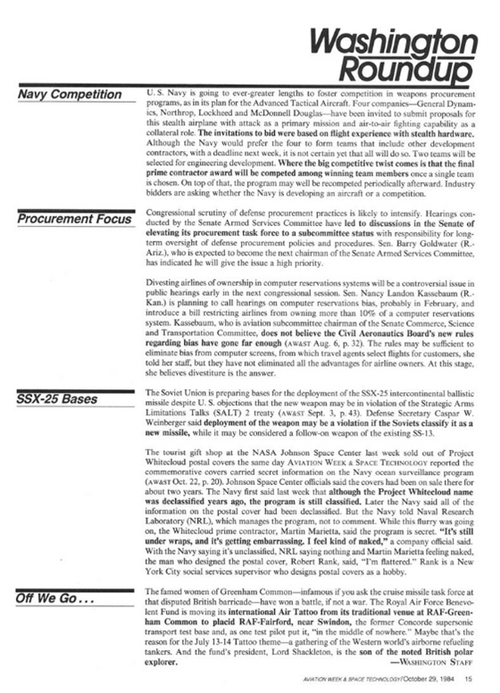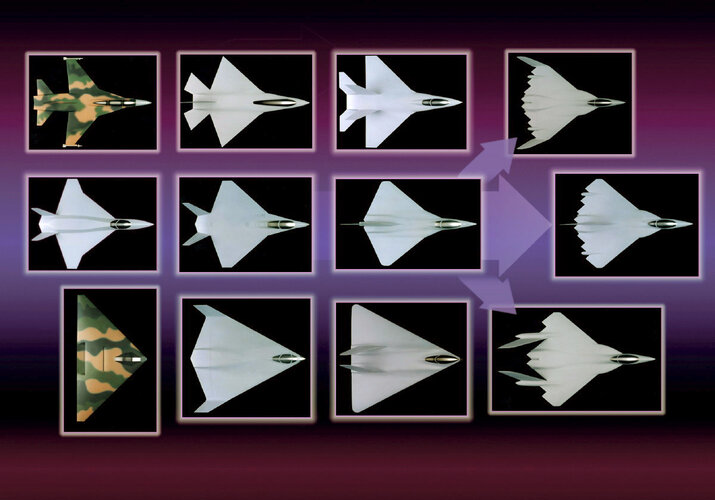>>
Was filed in 1975 and granted in 1977. That patent was based on work done between 1973-1974 in the Ryan "Low RCS Vehicle Study" was was in turn based on the Low RCS Vehicle Prototype proposal and PINE RIDGE work.
>>
"During the time that Lockheed Martin and Northtrop were in heavy competition, Keith Jackson and his crew at General Dynamics were working on what would eventually be known as the A-12. While Jackson had an inkling that something was going on involving DARPA, he did not have any details. Nevertheless General Dynamics had evolved a one-quarter scale model of an airplane they called 'Cold Pigeon."
Page 23 T5BDM, James Stevenson.
Later on that page it is mentioned that the data used for the Model 100 (which ceased being called that when a GD company official mentioned it to an aerospace reporter) was based on the AIMVAL/ACEVAL exercises, a specifically Air to Air related spectrum which actually fell more into line with the original work by Colonel Chuck Myer on a BVR centric fighter which would fly at high level and be supersonic cruise capable.
XST and ATB were both bombers.
>>
The patent was not issued or published in 1981.
>>
Which is why I put a squiggly ~. Dates, Numbers, so many, so confoozed.
Note, so as not to risk copyright infringement, I will not quote exact text anymore, thus note the shift from quotation to paraphrasing semi-quote marks.
The pages the paraphrasing come from, in _The Five Billion Dollar Misunderstanding_ by James Stevenson, will be accurate. The Author, his due.
Damn you sir, I'm eating Chinese Noodles because you won't republish your bloody book and all the secondhand market prices are insanely high! I'm going to end up hating Ramen Noodles. Who hates Chinese Noodles?!
'Jackson: 'We step up efforts to get considered in the ATB effort.' ... In October 1981, GD begins to accumulate funding for a dedicated Low Observables engineering team. In November, Jackson becomes aware of the Wintersdorf patent and gives a briefing to Tom Christie at PA&E on VX-11. Evidence supporting flying wings being superior Low Observables baselines accumulates. Tom Hahn, an R&D subcommittee aide and later Patent Attorney, suggests that the A-12 may violate the Winterdorf patent.'
Page 26 T5BDM, James Stevenson.
>>
The General Dynamics "HAVE KEY" etc. concepts were formulated in (IIRC) 1975-1978 as part of their work on ATS/ATSIE. This was independent of any of the Ryan work, and it is very unlikely that GD was aware of that work. The Air Force, however, was well aware of it.
>>
'In August 1983, DOD Top Level Acquisition Bureaucrats (Chu, Christie, Thayer, Delauer, Puritano) met to attempt to end USN deep strike. 'We had been trying to get rid of the A-6E since 1974.'
...
In June, Keith Jackson was told the Have Key was considered a direct threat to the ATF Program. Paul Kaminski said that the USN was not interested in stealth. John Lehman said the A-6F was not a 70 million dollar airframe, but more like 28 million and the A-12 was 20% over that, flyaway. GDFW manager Herb Rogers cancels Have Key investments to begin investments in ATF.'
Pages 32-33, T5BDM, James Stevenson.
Whether is sabotage of Grumman, Navy Strike or the A-6 specifically: 'Lehman is given The Word by Thayer, to begin looking at a 'new airplane' to replace the A-6. It is understood that 'New' means stealth. Lehman says 'Aye Aye Sir!' and begins to establish a Blue Ribbon commission, filled with naval and marine aviators to kill the proto A-12.
At least until the 1990s, when his own term will be done and Grumman will be flush with A-6F and F-14D orders.
Chu warns Christie, Christie puts the bug in Thayer's ear that the fix is in on the Blue Ribbon Panel. Thayer counter-salts the Hans Mark Commission with rivals from LTV who need a new design, real bad, as the A-7 fades into the sunset.
Page 35, T5BDM, James Stevenson.
'Battista (bigwig Beltway analyst and Congressional lobbyist) says that the Navy doesn't want MRASM (mini-Tomahawk) because it's a 200nm standoff missile and the A-6 can penetrate, just fine, with 60nm Harpoon. Lehman says, 'I've been to the White Sands Landship, fought the big exercises, the only way you can get in is with a roll back approach, peeling away the layers, at night. Battista rejoins with the USAF never being willing to buy a subsonic followon to a supersonic precursor because...Fun Ferrari vs. Ford Bomb Truck. I mean, wasn't the A-10 enough?
Meanwhile, (1984) Keith Jackson writes in his journal: 'There is a rush to team, am told by Navy higher ups that we are one of three qualified contractors for the ATA'. McDonnell Douglas (F-4, F/A-18) is not one of them. The downselect requirement is stealth.
Page 59, T5BDM, James Stevenson.
Nothing to say here so much as to note the drawings and charts for Configuration 403 which looks like a blended and chined F-14 with F-111 inlets and is referred to as an 'intermediate supersonic strike system'. Of the key performance parameters, the noteworthy ones are that it has a 997nm strike radius compared to the A-6E's 560nm one and a MTOGW of 73,000lbs. Right on the edge of carrier suitability. There are also strike and multirole configurations of an alternative, flying wing, system.
Page 69-71, T5BDM, James Stevenson.
>>
Both Lockheed and McDD submitted proposals for ATB in addition to Northrop.
>>
ATB is a flying wing. Which was only announced, late in the Carter Administration, to make it sound like the B-1A cancellation was a good idea and Jimmy Carter was 'strong on defense'. Then Iran happened.
Yet the important footnotes here are that the Wintersdorf patent is not a flying wing but more of a lifting body/blended wing body. Cold Pigeon is a flying wing. While the SLO/Missileer concept was one of the early ATF configurations considered (Battlecruiser, Bushwacker, SCM/SDM and Missileer) it was also one of the ones most rapdily removed.
The USAF had no reason to fear the Model 100 or Have Key because, assuming the image is accurate (and the Wintersdorf patent one as well) they could not do the intended mission which was deep penetration into defended airspace to break up concentrations of enemy fighter intercept or HVAA supporting platforms. Which is kind've what Colonel Myers was working on and what likely came out of AIMVAL/ACEVAL, if anything.
While a subsonic aircraft can fly overtop (by altitude) most M-SAM, once caught by HiMADS, it's done. Stealth would have to be really REALLY good to defeat this and the X the configuration of VLO which was best suited to this role, from the XST program, was not the Lockheed variant but the Northrop one. With a 13:1 vs. 1,000:1 baseline modifier respectively.
The Northrop XST also looks like a lifting body with an F-107 style inlet. But the Northrop B-2 is a flying wing. Someone made a change from XST to ATB. And it wasn't GD and the Model 100/Have Key team.
Is this important when considering the Top Sail/Steer/Plate radars of the Fregat equipped Sovremeniy, Slava and Kirov classes as the primary naval AAW threat? Yes.
Lehman says, somewhere in the text, that _his view_ of the ATA was a special squadron, kept somewhere remote in the desert, training against threat complexes, then flown out to the boat, at need, as a pathfinder force. Where they could target for the MRASM or TASM or whatever.
>>
None of the GD Sneaky Pete / Model 100 / etc. concepts were supersonic.
>>
No but the VFMX ones were. What caused the change? Payload? The Intermediate Supersonic Strike could carry three Mk.83. Or Stealth?
Yet the ATA is not stealth. Despite Jackson saying his team were 'stealth specialists' and the USAF saying Have Key was a threat to ATF which rapidly necked down to being both stealth AND supersonic.
If Have Key is a subsonic flying wing, the Northrop configuration of Stealth is oriented towards high level defeat of surveillance radars and GD is considered a 'specialist technology house' in one of the two areas which would interest the USN (Carrier Suitability being the other, where GD had _zero_ experience but MDC did...) then it stands to reason that that company which put together a specific VLO engineering team at the very beginning of the 1980s, would be designing a VLO specific platform for the Navy. A flying wing with extremely short pitch couple and large float is not your first choice for a carrier landing airframe with high sink rates and the need for precision scatter control on a narrow angle deck.
Put more bluntly: if Jackson thought his Model 100 was suitable for the (known stealth) ATB. And the USAF considered Have Key to be a direct threat to ATF because it was stealthy, not because it was fast. Then why was the A-12 subsequently not a threat to USAF _and_ not VLO, if it is based on GD experience from Have Key and the Model 100?
The ATA precursor concept has stealth as a primary design driver for which Stealth Gurus like Paul Kaminsky called GD a primary (one of three) stealth contrators. But the derived naval strike fighter doesn't?!?
A-durrrr.
>>
The GD work was not a copy of the Ryan work. They each arrived at their designs independently.
>>
So you are saying the Model 100/Have Key are stealthy?
Did I hear that correctly?
Lies, lies tell me sweet little lies... I mean everyone knows the A-12 was never stealth.
Even though ATA was not a multirole strike or air superiority platform and so could not defend itself from radar threats, even at night, especially at high altitude.
VFMX/VX-11 was both of those things, but only in one specific configuration that was not a flying wing and whose drawing does not look stealthy. ATA was descended from a specific technology line which was so serious a stealth progenitor that the USAF considered it a threat to their ATF. And which, at one time, it's designed considered to be a contender for ATB, which has a different approach to stealth but was never, itself, considered solely because it was a flying wing.
The A-12's chief opponent in the Navy wanted it to be a pathfinder, even though, by his own consideration, it was only a 34 million dollar platform compared to the 28 million dollar A-6F that was his heart's true desire and so he could have afforded both. Because he didn't need more than about 50-100 'new' jets. Just like the USAF didn't need more than 60 F-117As.
Someone who is trying to change a targeter platform into something else. Someone who wants to make a gatherer to replace the U-2 in the pre 'Tier' (TR/Tactical Recce) days of the U-2R as TR-1.
Who does this? FOIA. The Family Of Intelligence Agencies. Trying to break into stealth.
Model 100 _did_ catch someone's attention as Jackson shopped it around. But it wasn't the uniformed service's eye. They were just a cover.
And by attaching the Have Key configuration to an unlikely Naval Interdictor in a WORLD VIEW where the top procurement folks at DOD wanted to end Grumman or at least Naval Strike, these 'donor class' stealth wannabes in the defense peanut gallery thought they could attach themselves to a configuration which, if it failed as a naval strike airframe, could be taken into a gatherer/collector platform using large internal bays which could fit a 110" LOROP camera and a film cannister or SLAR or a monstrous ESM farm.
So explain why I am wrong, slowly, as you would to a small child or a golden retriever, that I might understand what Have Key, Model 100 and Cold Pigeon really were and how they 'fit in', in relation to the more well-known programs of the XST/Have Blue, F-117/Senior Trend, And ATB/Senior Ice.
But not Bravery. Whose trigram is straight out of the Intel world.
Thus, do I sit at the feet of the master, ready to receive the legend of a long dead program which your encyclopedic knowledge clearly knows quite a bit. Can you not, in your great wisdom, preserve for the ages the sacred knowledge by lifting the curtain on the briefing board so that the collection of GD technology demonstration efforts and assembly of a large observables engineering team, in 1980, at the perfect time for ATA to be linked to GD would NOT see the subsequent A-12 be designed stealthily? This part of the dark fairy whispers surrounding the Avenger II program particularly fascinates me because it is so completely incongruent with the revealed pattern of it's engineering descendancy.
If not ATA, then what? If not coherent reason then at least choate coverup. The program is 45 years old.
Why did Paul Kaminsky, the Hans Kammler of the Reagan Era stealth development/procurement bureaucracy, executive secretary of the LOCLOEXCOM himself, say that GD was 'One of three' technology sources for Stealth. Can you do even that much?
Please. Thank You. BRR.












